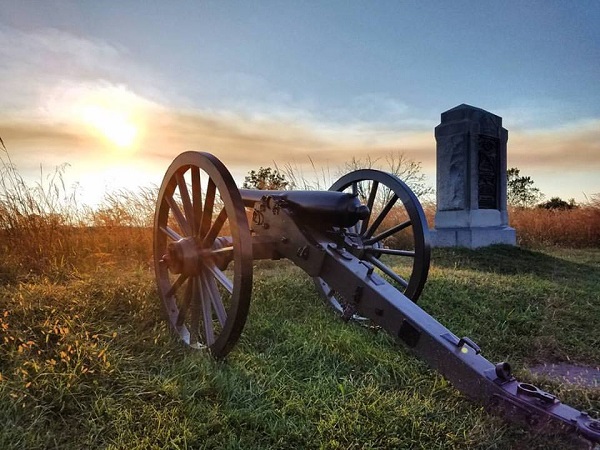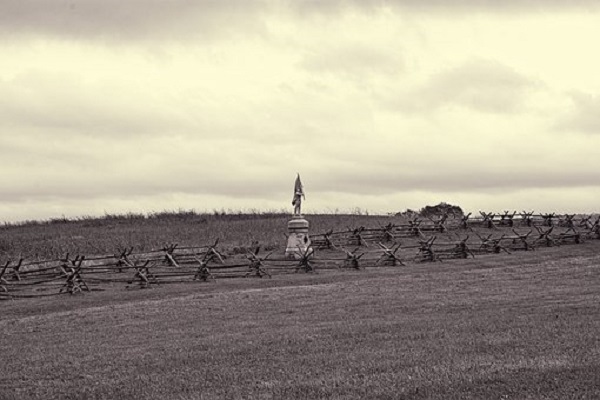Vacation in Gettysburg
By Catalogs Editorial Staff

Gettysburg National Park Preserves the Site of Historic Battle
Gettysburg National Military Park, established in 1895, is in Gettysburg, Pennsylvania, and preserves the site of the Battle of Gettysburg, fought in July 1863. The battle is considered the bloodiest and most decisive confrontation of the American Civil War (1861-1865). More than 25,000 Confederate casualties and 23,000 Union casualties resulted in the three days of fighting that led to a Union victory. The park contains more than 1,300 monuments, including statues of Confederate general Robert E. Lee and Union general George G. Meade, the Eternal Light Peace Memorial, a large bronze urn with a permanent flame; and memorials erected by many states. Gettysburg National Cemetery, where more than 7,000 men are buried, is next to the park. United States president Abraham Lincoln (1861-1865) delivered his famous Gettysburg Address at the dedication of the cemetery on November 19, 1863. The Gettysburg National Park is administered by the National Park Service and covers 5,990 acres. To make all your arrangements online, visit the site of the Gettysburg Convention & Visitors Bureau.
According to Microsoft® Encarta® Online Encyclopedia 2005, “The American Civil War is sometimes called the War Between the States, the War of Rebellion, or the War for Southern Independence. It began on April 12, 1861, when Confederate General P. G. T. Beauregard opened fire on Fort Sumter in Charleston Harbor, South Carolina, and lasted until May 26, 1865, when the last Confederate army surrendered. The war took more than 600,000 lives, destroyed property valued at $5 billion, brought freedom to 4 million black slaves, and opened wounds that have not yet completely healed more than 125 years later. The chief and immediate cause of the war was slavery. Southern states, including the 11 states that formed the Confederacy, depended on slavery to support their economy. Southerners used slave labor to produce crops, especially cotton.

Although slavery was illegal in the Northern states, only a small proportion of Northerners actively opposed it. The main debate between the North and the South on the eve of the war was whether slavery should be permitted in the Western territories recently acquired during the Mexican War (1846-1848), including New Mexico, part of California, and Utah. Opponents of slavery were concerned about its expansion, in part because they did not want to compete against slave labor. Although compromises had kept the Union together for many years, in 1860 the situation was explosive. The election of Abraham Lincoln as president was viewed by the South as a threat to slavery and ignited the war.”
The Battle of Gettysburg, fought July 1 through July 3, 1863, is considered by most military historians as the turning point in the American Civil War. The Battle of Gettysburg was a decisive engagement in that it arrested the Confederates’ second and last major invasion of the North, destroyed their offensive strategy, and forced them to fight a defensive war in which the inadequacies of their manufacturing capacity and transportation facilities doomed them to defeat.
With the repulse of Pickett’s Charge, the Battle of Gettysburg was virtually over. On the night of July 4, Lee began his retreat to Virginia, expecting a counterattack from the federal army. Meade, however, did not attack, due perhaps to heavy rains which hampered pursuit of the retreating Confederates. During the three days of battle, the Union Army had about 23,000 casualties, and the Confederates had at least 25,000.
Tourism is virtually the only industry in the Pocono Mountains, long a popular resort area. In the more rugged woodlands of the Alleghenies several summer and winter resort areas have been developed, including a number of ski resorts. In addition, Pennsylvania’s many historic sites attract millions of visitors yearly.

Philadelphia is the largest city in Pennsylvania. It was founded in 1682 by English Quaker William Penn, Philadelphia is known as the Birthplace of the Nation because of its role in America’s struggle for independence from Britain. Both the Declaration of Independence and the Constitution of the United States were drafted in the city. The name Philadelphia was derived from the Greek words meaning “city of brotherly love,” and Penn opened his city to people of many different religious and ethnic backgrounds. Modern Philadelphia has worked hard to maintain that diversity while becoming one the great commercial, cultural, and educational centers in the United States.
The city of Philadelphia, which since 1854 has had the same boundaries as the county of Philadelphia, is located in the southeastern corner of the state, at the junction of the Delaware River and Schuylkill River. A major port, the city lies about 160 km (about 100 mi) inland from the Atlantic Ocean and is situated approximately halfway between New York City and Washington, D.C. It has become one of the major Pennsylvania tourism attractions.
Popular Savings Offers
Included among the Pennsylvania Germans are several religious sects, such as the Mennonites. Although members of these sects make up a small portion of the Pennsylvania German population, they are particularly well known because they tend to reject worldly concerns and cling staunchly to their old standards and manners. The Old Order Amish, an offshoot of the Mennonites, have refused to adopt such modern devices as automobiles and motorized farm machinery. The Amish can be easily recognized in many rural areas by their simple yet distinctive clothing and by their horse-drawn wagons. The Gettysburg Convention & Visitors Bureau can advise you about side trips to Amish areas which are high on the list of Pennsylvania tourism attractions.











